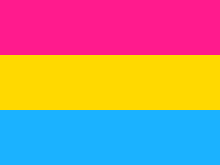Pansexual pride flag

| LGBT symbols |
|---|
| Flags |
| Other symbols |
The pansexual pride flag was designed as a symbol for the pansexual community to use. The pansexual pride flag has been found on various internet sites since mid-2010.[1][2] It is similar to the LGBT flag, which is used as a symbol for the lesbian, gay, bisexual, and transgender community. The pansexual pride flag is used to increase visibility and recognition for the pansexual community, and to distinguish it from bisexuality.[3] It is used to indicate that pansexuals have romantic attractions and relationships with people of different genders and sexualities.[4] The theory of pansexuality aims to challenge existing prejudices, which can cause judgment, ostracism, and serious disorders within society.[5]
Design
Many confuse bisexuality and pansexuality, especially when it comes to differentiating the flags. Each flag has three horizontal bars and they each hold three different colors. The pansexual flag consists of three colored horizontal bars: pink, yellow, and blue.[6][7] The blue portion of the flag represents those who identify within the male spectrum (regardless of biological sex), the pink represents those who identify within the female spectrum (regardless of biological sex), and the yellow portion, found in between the blue and pink portions, represents non-binary attraction such as androgynous,[4] agender, bigender and genderfluid people.[8][9][10][11][12]
The bisexual pride flag on the other hand has three horizontal bars of other colors: pink, purple, and blue.[4] The pink portion of the flag represents sexual attraction to the same sex, the blue portion of the flag represents sexual attraction to the opposite sex, and the overlapping purple portion of the flag represents sexual attraction to both sexes.[4]
See also
| Wikimedia Commons has media related to Sexual identity symbols. |
- LGBT symbols, other LGBT symbols
- Other flags in the LGBT community:
References
- ↑ Pansexual Pride Flag, 2010-10-08, archived from the original on 2011-11-03 .
- ↑ "Do You Have a Flag?". 9 November 2012. Retrieved 17 July 2014.
- ↑ Petronzio, Matt. "A Storied Glossary of Iconic LGBT Flags and Symbols". MashableUK. Retrieved 17 January 2015.
- 1 2 3 4 STOP-Homophobia (2017). "What is Pansexual?". Retrieved 3 June 2018.
- ↑ Boom, Peter. "The Philosophy of pansexuality". European Federation of Sexology. Retrieved February 12, 2016.
- ↑ "Pansexual Pride Day". Shenandoah University. Retrieved 17 July 2014.
- ↑ "Gender Identity/Expression and Sexual Orientation Resource Center - Pansexuality". Washington State University. Archived from the original on 26 July 2014. Retrieved 17 July 2014.
- ↑ "A field guide to Pride flags". 27 June 2013. Retrieved 17 July 2014.
- ↑ "A Storied Glossary of Iconic LGBT Flags and Symbols". 13 June 2014. Retrieved 17 July 2014.
- ↑ "Cantú Queer Center - Sexuality Resources". Retrieved 17 July 2014.
- ↑ Pansexual Pride Flag, 2010-08-11, archived from the original on 2011-08-24 .
- ↑ "Mashable publishes an up-to-date compilation of LGBT flags and symbols". GLAAD. 16 June 2014. Retrieved 17 July 2014.